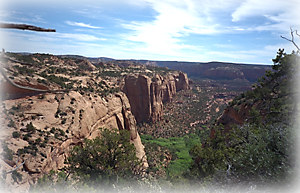November 13, 1998
The lands of southern Utah and northern Arizona hide many places with rich cultural and geologic history. Navajo National Monument, 20 miles southwest of Kayenta, Ariz., is one of those places.
 Tucked away in remote Tsegi Canyon, the monument surrounds a small desert oasis, a place abundant in plant life, with mountain mahogany, Gambel oak, serviceberry, rice grass and Douglas fir scattered across the canyon.
Tucked away in remote Tsegi Canyon, the monument surrounds a small desert oasis, a place abundant in plant life, with mountain mahogany, Gambel oak, serviceberry, rice grass and Douglas fir scattered across the canyon.
This area, together with Mesa Verde and Chaco, was one of the important centers for ancestral Pueblo cultures.
Two main ruins, Betatakin and Keet Seel, are limited-access sites that contain dwellings dating from 950-1300 A.D.
A few short developed trails behind the visitor center take the hiker down into the canyon and offer views of Betatakin. Five-hour roundtrip hikes, accompanied by a ranger, take place from May to September. Backcountry permits are required for the 8.5-mile trail to Keet Seel.
A small but tidy campground near the visitor center offers nice accommodations for the car camper.
The wooded areas of Navajo National Monument are known as an example of a “relic forest,” a survivor of an Ice Age environment.
Although our stay here was short, Navajo National Monument proved an enchanting place well worth a second visit.
David Iler